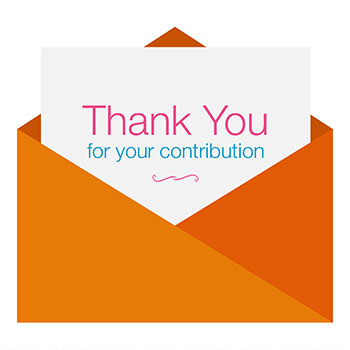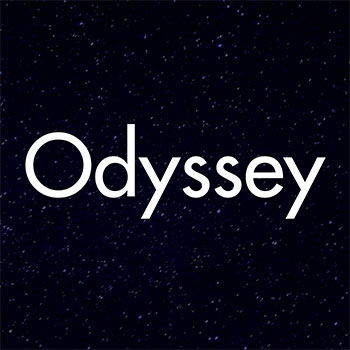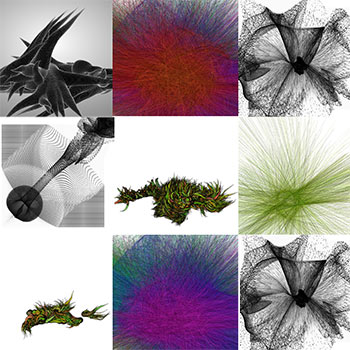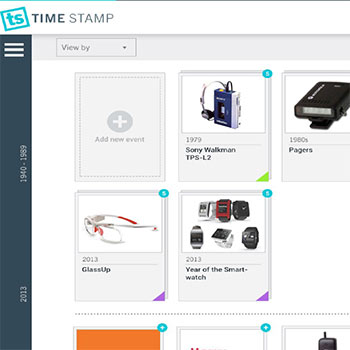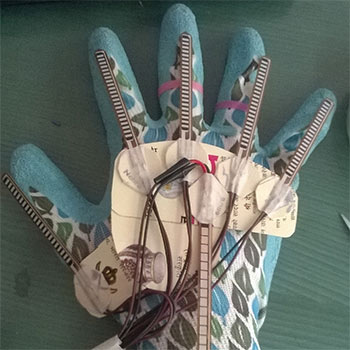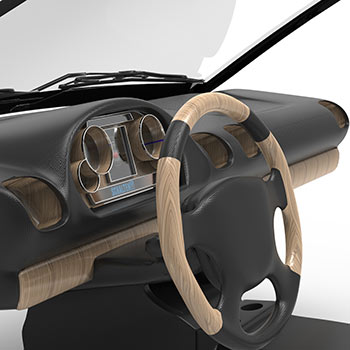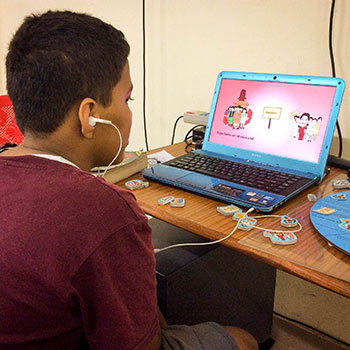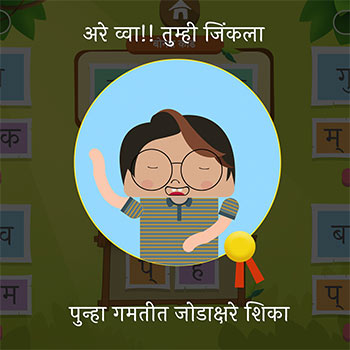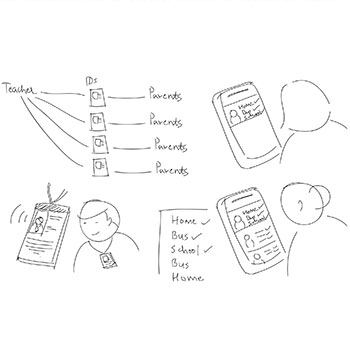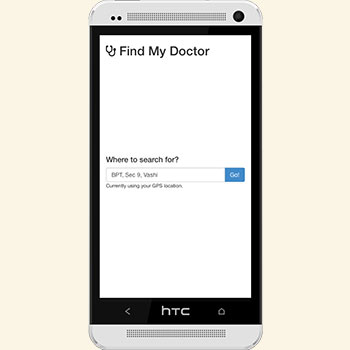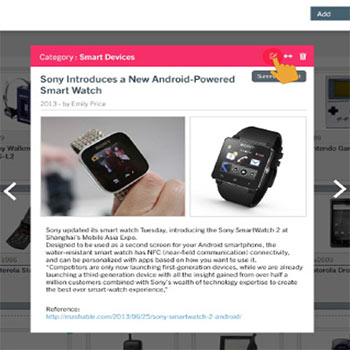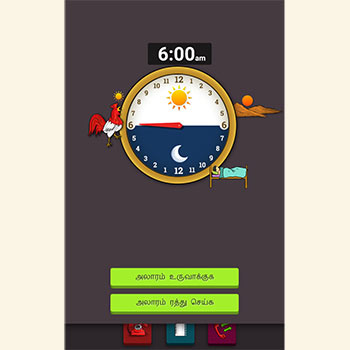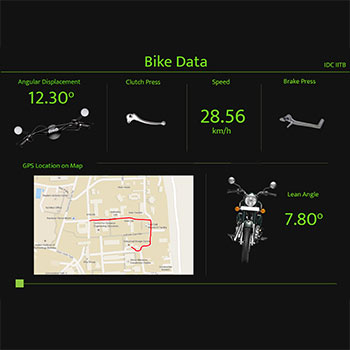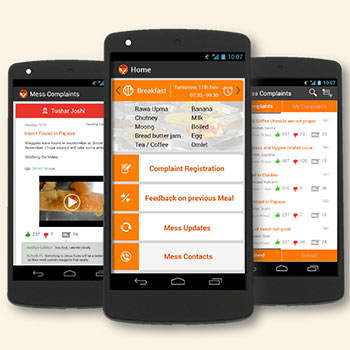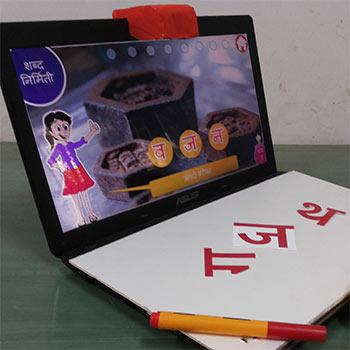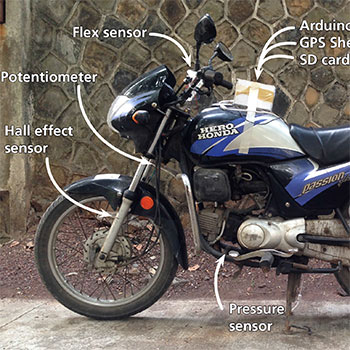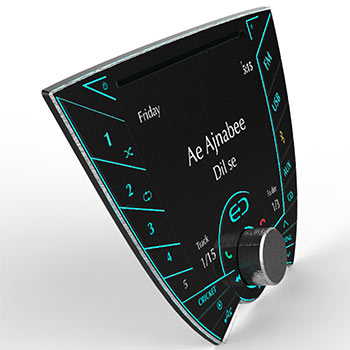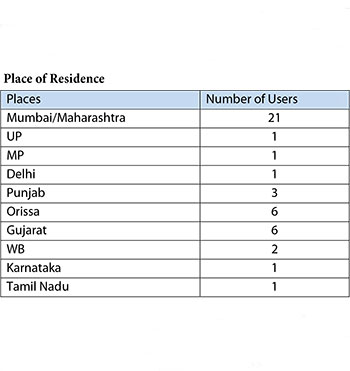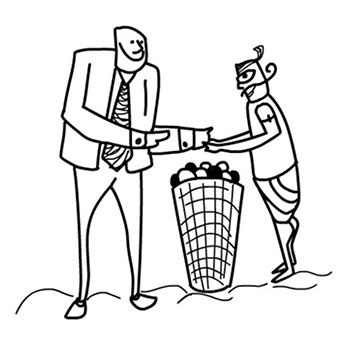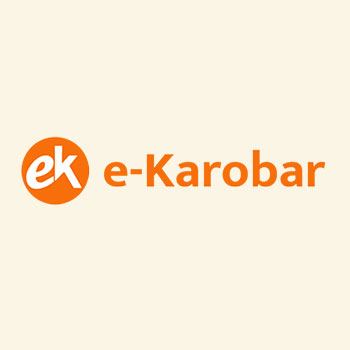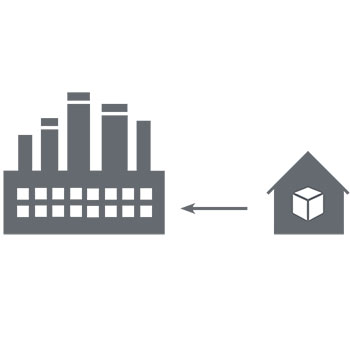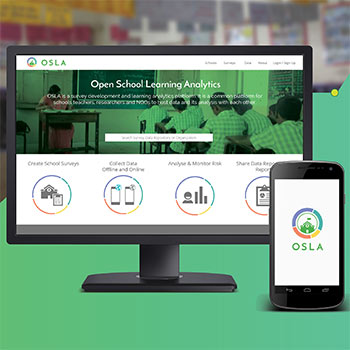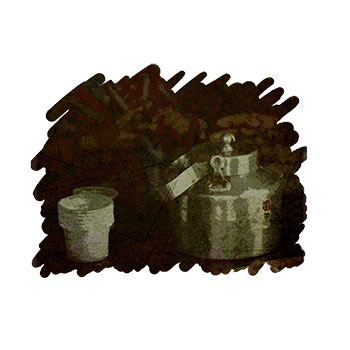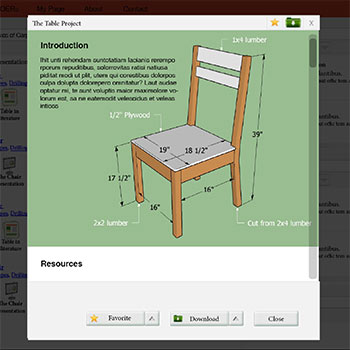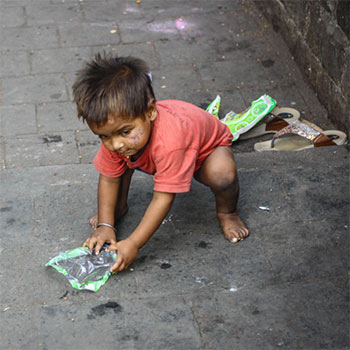Interaction Design
Batch 2013-2015
(42 items)
Interaction DesignBatch 2013-2015
(42 items)
(42 items)
Dabbawala: Service and Mobile Application Design
by Abhishek Chakraborty
by Abhishek Chakraborty
The dabbawalas (tiffin carriers) of Mumbai are a unique community of around five thousand people who efficiently serve up to 2 lac (0.2 million) customers every day. They have been delivering daily lunches from homes to offices for over a century and any kind of error in their delivery process is almost negligible. They have maintained their heritage working process since the inception of the service and therefore any kind of technology has not been incorporated in their work. They are currently facing numerous business sustainability challenges such as reaching out to new customers and also in maintaining their existing customer base. In 8-10 years, the number of customers a dabbawala serves a day has reduced from 50 to around 20 now. Through our research we have understood that they will lose their current customer base soon as similar food delivery businesses with faster and better services are emerging. To empower them we introduce Dabbawala — a mobile application that enables partnership between dabbawalas and food services around the city and directly connects them to their combined customer base. This application enables the customers to order lunch from anywhere in the city. Customer registrations and any kind of money transactions are all handled through the application. The application is also used within the Dabbawala community to manage teams and responsibilities.
Details >>UI Design for QBO UGC
by Abhishek Chakraborty
by Abhishek Chakraborty
QuickBooks is an accounting software package developed and marketed by Intuit. There are Basic and Pro versions of the software including other industry-specific versions, with workflow processes and reports designed for each of these business types.
QBO= QuickBooks have mainly two editions, the QuickBooks Desktop (QBDT) which is a software package which has to be installed in the system and only then can it be used, and the QuickBooks Online (QBO), which is an online version of QuickBooks and Intuit is providing it as Software as a service (SAAS).
QBO UGC= QBO had been launched in France recently and the QBO User Generated Content team had been setup whose main purpose was to gather contributed
data from the users (and non-users as well) such as invoice formats, Chart of Accounts (COAs), billing formats, tax rates etc. so as to save a lot of legwork when the product is launched in other countries as well.
Details >>Teaching Astronomy to Children
by Abhishek Chakraborty
by Abhishek Chakraborty
“Never memorize what you can look up in books.” — Albert Einstein
Facts can be memorized, but the Universe has to be experienced.
It is vast and beyond comprehension. The scale of the planets,
the distance between them, motions of earth, the tilt in earth’s rotational axis, the changing seasons and the reasons behind
these phenomena are difficult to visualize as there is no scope of direct exposure. Children of age group 10 to 14 face difficulties to understand these concepts when they are introduced for the first time. As per observations, 2D renderings on paper in text books and videos are not sufficient enough to teach these concepts accurately. In these mediums, the communication is very much one sided. They need something to interact with and test out their mental model
of the Solar System. The objective of this project is to provide an interactive medium which will enable students to tinker with it and help them understand these concepts better.
Odyssey, a Solar System Simulator is designed which creates a realistic simulation of the positions of the planets and various other events in our Solar System. The whole system is designed taking into account the mass and gravitational forces acting between the planets. A child is expected to select a time of the year and the system perpetually tracks the information and provides a real time visual feedback of the position of the planets ensuring the learning of the concept. Realistic 3D models of the planets help a child in identifying the planets according to their textures and commit to memory.
The designed platform can also be used effectively to teach other similar concepts like the reason behind change in seasons on the earth throughout the year, the phases of the moon, solar and lunar eclipse etc.
Details >>Streakle: A Discovery, Discussion and Networking Platform for Design Students
by Abhishek Chakraborty
by Abhishek Chakraborty
Feedback is important for cultivating creativity. Constructive feedback on design is crucial for helping students and amateur designers iterate toward better solutions. However, most of the current platforms don’t promote candid design feedback and are largely used for self-promotion. The primary users
of portfolio sites like Behance and Dribbble are design professionals and their key purpose is to connect with potential clients or firms for jobs. Feedback on portfolio sites are simplistic, and since they all are follower based communities, fewer followers means less feedback. It is hard to meet likeminded strangers through these platforms as there is no productive discussion and comments
are typically reduced to mere back patting. Networking among students is generally limited to design festivals, competitions and conferences. The lack of an active network among students creates pockets of brilliance where the shared intelligence of the students gets limited to their school campus and rarely goes beyond that. This in turn deters students from having considerable
chances of interacting with students outside their community. Any kind of platform for design students to share hobby works and network with other like-minded students is absent.
This project proposes Streakle, a feedback and networking platform for design students to share and discuss works, get feedback, and network with others. Users interpret the designs based on the context stated by the designer and share feedback through comments and annotations. The group chat feature enables users to discuss works and other topics spontaneously. It is not a follower based community and users choose to follow topics of their interest instead of people. When someone shares anything related to the users’ interest it appears in their feed.
Details >>Data Generative Art Installation
by Debasish Biswas
by Debasish Biswas
Can a computer create art? Can a machine embrace the creative process. These were the questions I wanted to find answers
to with this Design Research Seminar.
The intention was to research on relevant literature and implement some of the learnings.
The research aims at implementing a data generative art installation. An exhibition
of artwork that generates art as viewer interacts with it. The movement and presence of the viewer is used as data. Different algorithm give different character to similar input data. These generated images then creates another collage which keeps one changing as newer images are generated by viewers.
This final collage is the culmination of experiences of all the viewers of this installation. This installation will itself create data and use it make generative art.
Details >>Develepment of a Timeline Tool
by Debasish Biswas
by Debasish Biswas
In this internship requires to gain knowledge to develop an opinion on the past and future of mobile computing. This objectives will be achieved by adding significant events to the existing Mobile Computing Timeline developed by bRnd Studio. Using the lens of hardware, software and services to tell each story. This exercise will lay the ground work for the next phase of the internship.
Based on the learning of the first exercise, sketch and prototype a web based research tool that assists in gathering and visualizing historical data. To do this start by benchmarking existing timeline tools and other applications like pintrest, flipboard etc. Then brainstorm what a Timeline Tool would look and feel like. Follow that by creating a flow analysis of the tool in mind. Develop screen shots and animations of the interactions the tool will offer. The tool should assist the user in archiving facts found on the internet at the time of discovery, while also giving them the ability to add a written summary, images, audio or video to the finding before saving them to the database.
Once the content has been added to the database the user should have the ability to view the data in multiple ways such as timelines, lists, 2X2 matrixes etc. In addition users should
be able to add comments and share events with others directly from the tool. The aesthetic of the online solution should complement the physical Timeline cards developed by bRnd Studio.
The tool should have a clear, simple and effective interface while being easy to use. The initial target user for such a system are members of a design research and development teams.
Details >>Rethinking Grocery Shopping for Supermarkets
by Debasish Biswas
by Debasish Biswas
Grocery shopping has always been a part of our Indian lifestyle, be it local kirana stores or the recently popular supermarkets. But, shopping in general has undergone drastic changes over past decade and so has the shopping behavior along with it. Today while online shopping sites provide an array of tools that help customers gain insight during the purchase decision process, retailers provide few such tools in stores for the consumers.
All medium of grocery shopping like kirana shop, supermarket or more recent online grocery shopping, has its own importance and need for existence. But there is been a change. Today users have evolved shopping practices and use multiple channels to search, compare and purchase products and services. Now that customers are entering supermarkets with technology in-hand, the focus must expand to providing product insight to the customer as well. By providing customers with product insight, retailers can provide a differentiated experience that increases loyalty, which can in turn increase revenue. This will in turn increase choices for the consumers.
The project aims at giving user a decision aid system that works outside as well as at the physical grocery store. The design solution will allow user to search, compare and list items they need for their grocery and then share this list with the retailers so they can use this list information to provide better services to the user. The project will contribute to understanding the current market trends and development of a detailed prototype.
Though the solutions is intended to serve independent youths in urban areas, it can equally benefit middle class families of both nuclear and joint.
Details >>Evolve- A Physical media tool for kids to play & learn
by Debasish Biswas
by Debasish Biswas
Kids are playful and imaginative by nature. Digital media games has become very popular among kids these days and this trend is just going to peak as we get more depended on digital technology. How should kids interact with digital media?
Secondly, the current education system is like an industrial production line setup. Forcing kids to not grow at their own pace. Children need conducive learning environment to play and learn. Kids can learn best from experiential learning. The goal of this project is creation of a new play and learn environment, which is tightly interwoven with a child’s everyday live through the objects and devices that surround him/her and the spaces they inhabit.
This project is attempt to provide a play and learn platform using physical toys from kid’s world. I looked at using puppets as facilitators for learning. Physical toys such as puppets are from the realm of a child’s imagination and therefore they relate to it. The platform will allow kids to participate in active role playing game-play and interact with their environment using a puppet glove. This play
& learn platform consists of a multi-sensorial physical glove with gesture based input and a content module with different games .
The project contributed to study and classification of games/toys. It also contributed to classification of social gestures. A set of nine gestures were derived and implemented from these studies. These gestures were mapped on to a physical puppet, e.g. moving the hands of the puppet will move the virtual character’s hand onscreen. The final set of gestures were arrived at after testing with kids for intuitiveness and ease of use. The project contributed to implementation of a working prototype. The prototype consists of the puppet glove and three working game modules with finalized set of gestures.
Details >>User Study on Blind and their Navigation Behaviour inLocal Trains
by Kalyani S Dhone
by Kalyani S Dhone
In Mumbai most of the people travels by Local train as it is connected to all the places, but the routes of these trains are complex and difficult to understand.
It is always interesting to know how the blind people must be travelling without any vision and how they navigate from one place to another in city like Mumbai.
The user study is aimed to understand, how blind people travel in local trains. In this user study, we tried to understand - How blind people get information, what are the techniques and methods they use to
get this information, what are the problems they are facing currently
in traveling, the different resources and assistive systems they use for communicating and navigation. Also, we tried to investigate their behaviour while travelling in Local trains, how they find correct trains and their destinations stations.
The focus user group was children, young people above 18 years and adults. From the gathered data, we tried to find observations and insights which may help in developing system for blinds for navigation in Mumbai local trains.
Details >>Design of Vehicle Instrument Cluster for Indian and German Audiences
by Kalyani S Dhone
by Kalyani S Dhone
Cultural differences play an important role in the design and development of new products Many examples of product failures have proven that the culture of a country has huge influence on the success of new product Against the background of the grow- ing importance of emerging markets it is even more important to understand these cultural differences to take them into account during the product design and development process Therefore, this Advanced Design Project has the goal to examine these cultural differences between India and Germany regarding the design of a dashboard of a B+-segment car (“Kleinwagen”, respec- tively ) and create two instrument clusters, which are based on these results - one for the Indian and one for the German market To guarantee an efficient and structured approach, a user cen- tered design process considering project management methods
is executed On that account a literature review regarding the user centered design process and the general dashboard design is executed Based on the insights of that literature review and its insights, a work breakdown structure is developed to structure the project in feasible work packages
Details >>Teaching Children Structure of Indian Government
by Kalyani S Dhone
by Kalyani S Dhone
Children get introduced to subject of civics or social political life at the age of 12. The purpose behind having these subjects as a part of curriculum includes making them familiar with government structure as well as helping them with understanding their roles and responsibilities as good citizen.
Through the user studies, it was found that the reason behind making these subjects boring includes old traditional in which way children are taught at school. Moreover outside schools children are not motivated enough to learn this subject.
So this project is aimed to make the structure of Indian parliament more interesting for children from early age.
The design processed is followed to understand the problem
and its different possible solutions. User studies, interviews were conducted to get close to the current existing methods of teaching and curriculum.
Based on the insights, final solution was designed which includes Tangible installation connected with the series of graphical animated videos where children can learn about five important components of the parliament - President, Prime Minister, Lok Sabha, Rajya Sabha, Council of Ministers.
The videos were designed in where emphasis is given on the key content of each component and its link with other component. The installation connected with the video helps the children to engage in videos and motivate to solve the puzzle given on the installation.
Evaluation was done on targeted user group with final prototype. Evaluation was done to understand the learning effectiveness and engagement of the user.
As part of future scope, there is a great need of change in teaching methods specially towards the subjects like civics which plays important part in everyone’s life. Changing the traditional methods with engaging interactive systems would drive children to actually learn subjects with interest.
Details >>Learning Game for teaching Devanagari Conjuncts to Children
by Kalyani S Dhone
by Kalyani S Dhone
Lack of reading and writing is always a barrier in child’s education and it also affects child progress. The idea behind this is to make an attempt to come up with a ‘Learning Toy’ which can help children in learning Marathi conjuncts. The main objective is to make a child understand the formation of the conjunct with engagement and fun.
User studies were conducted with teachers and children in BMC schools and it was found that conjuncts are mainly taught by rote learning where the basic concept of formation of conjuncts doesn't get clear in child’s head. In addition to that, spoken language influences the child’s reading habits. It gets more difficult when they come across the conjuncts having special form like ??????, ????.
To solve this issue and understand the problem user studies were conducted in government schools where I tried to understand the current existing process of teaching and problems faced by children while reading and writing conjuncts. The studies were used to draw insights and observations, based on which different concepts were designed keeping the objectives and targeted user in mind.
As a final outcome, I came up with a game where child will be given a set of puzzles in which conjuncts will be given. In a game child plays with cards and learn formation of conjuncts.The game mainly provides the knowledge about sequence of letters combined in given conjunct. Making a two player game makes the game play interesting and challenging for each player. The game play is designed as a open card game. So while playing child tries make his own pair of conjuncts but at the same time he tries to block the opponent. The game provides the learning as well as social dynamics among the players.
The game was mainly divided into 6 different levels, based on the complexity and frequency of the conjuncts. Simpler conjuncts were integrated in first levels and difficult conjuncts were integrated in later stages. Physical (tangible) board game was made to understand the game play and learning effectiveness of product.
Preliminary Evaluation was done on the board game with targeted users. Based on the user’s feedback digital prototype was developed. Digital prototype was developed to add interactivity to the game with the help of sound and visuals. Three levels of digital prototype was evaluated with children to evaluate learning where it was mainly focused on sequencing of letters in conjuncts, pronunciation and engagement.
Details >>Envisioning Internet of Things in Indian Context
by Kaustubh Limaye
by Kaustubh Limaye
Currently we use internet for various purposes through computers and mobile phones. The next step for internet is digitally connecting our daily things to each other and to us. This trend is called as Internet of Things. It emerged as a creative application of RFID technology.
The aim of this project is to carry out a preliminary research study for identifying potential of IoT in India. As IoT products originated in west, their development is based on underlying assumptions which may not be valid in Indian context. As a part of this project, we studied the current state of IoT field and conceptualised IoT applications specific to India. We used these concepts as an ice breaker to have conversation with users in order to understand their concerns and inclinations. Finally, it helped us in coming up directions for further research and refining designed concepts.
Details >>Industrial Experience at Fractal Ink Design Studio
by Kaustubh Limaye
by Kaustubh Limaye
Fractal ink is a consultancy with a relentless focus on experiential and human-centric design. An award-winning design consultancy with a deep-rooted passion for creating human-centric experiences. Here I got to learn about visual hierarchy,affordance,usability considerations for mobile screens, wireframing, clarity of thought, team work etc. Hands-on experience with visual design on Windows phone, Windows tablet, and websites, as well as wireframing on Windows Phone.
Details >>Designing an alternate way to reach relevant primary heatlhcare practitioners in Navi Mumbai
by Kaustubh Limaye
by Kaustubh Limaye
For a migrant to an urban settlement like Navi Mumbai, deciding a primary healthcare service, is a task heavily influenced by the word-of-mouth effect. It is an important task as it is mostly the first encounter with the healthcare sys- tem. The credibility of the word-of-mouth phenomenon being doubtful, deci- sion making is a concern.
Based on the information needs and decision making criteria for healthcare decisions of users, this project tries to aid the first time health seekers reach relevant general practitioners with informed decisions through an informa- tion system making advantageous use of the word-of-mouth effect.
Considering a patient centric approach, a mobile application with search and connect features is presented as a solution. It facilitates search using user pref- erences, provides factual information about the general practitioners that is hidden, allows users to interact with friends and locals for getting assurance and acts as an appointment management tool.
Details >>Gamified usability testing Tool for Virtual marathi Keyboards on Android platform
by Kaustubh Limaye
by Kaustubh Limaye
The Marathi-speaking population is 71,936,894 (India 2011) There are approximately 8 crore people. It is estimated that 302 million people use the internet across the world. The Marathi Wikipedia has 34,000 articles and 23,000+ registered users. I investigated the touch behaviour on mobile devices’ virtual keyboards through the game "Type It" . The various data about the devices used and the performance of the players' user location, device name, time zone, and width-height of the virtual keyboard. Experimenters control most variables and conduct studies with a small number of participants in a lab (high internal and low external validity).
Details >>Emotions of a Dyslexic
by Maharaj M A
by Maharaj M A
‘Learning disabilities are basically neurological processing problems. These problems can interfere with learning skills like reading and writing and also math. Learning disability can sometimes affect higher level behaviors like organizing, reasoning, memorizing
and planning’[1]. Learning disability in a kid is generally tested in schools and the kids are given special training to perform well. Even though it cannot be cured, one can overcome this disability and be successful in life.
Details >>Develepment of a Timeline Tool
by Maharaj M A
by Maharaj M A
In this internship requires to gain knowledge to develop an opinion on the past and future of mobile computing. This objectives will be achieved by adding significant events to the existing Mobile Computing Timeline developed by bRnd Studio. Using the lens of hardware, software and services to tell each story. This exercise will lay the ground work for the next phase of the internship.
Based on the learning of the first exercise, sketch and prototype a web based research tool that assists in gathering and visualizing historical data. To do this start by benchmarking existing timeline tools and other applications like pintrest, flipboard etc. Then brainstorm what a Timeline Tool would look and feel like. Follow that by creating a flow analysis of the tool in mind. Develop screen shots and animations of the interactions the tool will offer. The tool should assist the user in archiving facts found on the internet at the time of discovery, while also giving them the ability to add a written summary, images, audio or video to the finding before saving them to the database.
Once the content has been added to the database the user should have the ability to view the data in multiple ways such as timelines, lists, 2X2 matrixes etc. In addition users should
be able to add comments and share events with others directly from the tool. The aesthetic of the online solution should complement the physical Timeline cards developed by bRnd Studio.
The tool should have a clear, simple and effective interface while being easy to use. The initial target user for such a system are members of a design research and development teams.
Details >>UI Localization of Touch phone for the Literate, but non-English proficient
by Maharaj M A
by Maharaj M A
The aim of this project is to design a localized user interface of smart phones for the literate, but non English proficient users. For Localization, one needs to culturally adapt the user interface. Efficient UI localization for Tamil speaking people is still not available. User study was done to learn about the cultural behaviour of the users, through which design heuristics were derived.
The design heuristics are:
1. Use text or voice assistance to direct the user.
2. Use localized metaphors or skeuomorphism.
3. Perform critical tasks only with these four gestures: single tap, press
and hold, swipe up and swipe down
4. Standardize interaction elements to be distinguished from other static
elements visually
5. Choose translation or transliteration based on the familiarity of terms. 6. Use illustrations representing events or actions.
7. Give less functions in a screen at a time.
8. Reveal features gradually.
Abstract
Interface design was tried out for three touch phone applications, namely, Alarm Clock, Phone Book and Message. The interface of these applications were redefined according to these heuristics. The designs were tested with the users, with a set of evaluation criteria.
From the evaluations it was found that the use of text and voice assistance along with translation and transliteration helped to a certain extent of performance. It failed at places where the user was not able to relate the content and the action to be performed. The heuristics related to visual like ‘use of metaphor and skeuomorphism’ were quite successful. It helped to understand and remember gestures too e.g: swipe to turn a page in phone book app. The structure related heuristics like ‘Give less functions in a screen at a time’ and ‘reveal features gradually’ failed to make the user understand the conceptual model.
Future scope for the project could be developing more applications based on these heuristics, which could be useful and adaptable for the selected user group. The project contributes in new ways for approaching localization of smart phones. It mainly focuses on giving the user the knowledge of how to use an interface when they encounter it for the first time. Also this project tries to prove that the heuristics derived can act as a base for designing any user interface for such user group.
Details >>Interconnecting the worlds of the dyslexic
by Maharaj M A
by Maharaj M A
Dyslexia is the most common learning disability affecting about one in every five kid. It is a disability which prevents children from reading at a level commensurate with general intelligence. Children with dyslexia have difficulty distinguishing alphabets and words, they also have great difficulty learning the connection between written letter patterns and the sound of it.
Generally, children with dyslexia tend to be active like normal kids and sometimes they are more hyper than the normal children. While working on this project, at some stage it was realized that dyslexia is not just about learning disability but there is more to it. The major problem with dyslexic people, especially the kids is
that their childhood becomes more miserable and hard for them to mix themselves with the society. Because of bad experiences they lose confidence which leads to emotional breakdown which in turn reflects in their learning and their self-development.
Here I have tried to deal with the learning problem considering the emotional barriers. This project focuses on creating a digital game learning environment for the kids to play and learn along with their parents. Together they explore the fantasy world where they enjoy, explore and learn.
The project focuses on solving this problem by creating a fun filled game environment where the kid does not feel bored to learn. Here, in this case the story line used for
the game play is a young dragon journey where the kid enacts the dragon and he has to play different game levels to complete the story. There are two games in this part of the story: One is arranging the birds in which the kid learns sequencing by visuals and sequencing letters. The other
is flying the dragon in which the kid learns about numbers. To make the game more lively two things are done, one in implementing an interactive dragon, where the kid talks with the dragon and the other is the use of gesture as controls for the game.
Details >>Two wheeler Data logging and visualization
by Piyush Vinod Churad
by Piyush Vinod Churad
In India, two-wheeler is amongst the popular mode of transportation. In the past decade, we’ve seen growth in the sales of two-wheelers [1]. With the advancement in technology, the efficiency and the of two wheelers have improved. Data logging can further help in improvement by recording and analysing various parameters.
The aim of the project is to develop a tool for logging data using low-cost physical computing devices. Different parameters of two-wheeler were moni- tored to understand user’s riding behavior. A variety of sensors were used for logging data. Arduino microprocessor was used for controlling and receiving data from sensor. Collected data is later visualized in Processing.
The tool monitors two-wheeler’s speed, GPS location, angular displacement of handle, tilt angle of vehicle, clutch lever usage and rear brake usage. The generated data can be used to find statistical correlation between different parameters.
Details >>Timbr : A loyalty program based experience design for Customers and Merchants
by Piyush Vinod Churad
by Piyush Vinod Churad
A merchant always wants his loyal customers to feel special every time they make use of the service being provided. Also for new customers, they should often visit and use the service whether it’s a shopping brand or a restaurant. The Customers want to save their time and money in terms of travelling, searching for offers and other expenses. They need rewards of being loyal to their favorite brand implicitly.
Shopping with smartphones and tablets is becoming increasingly popular. It saves your time, money and helps customers make smarter spending decisions by putting detailed information. In addition to that making use of newer technologies lives of both customers and merchants can be made easier.
The aim of this project, Timbr, is to design a loyalty program based expe- rience. It includes a mobile application for customers and a web based application for merchants. The design is based on the Beacon Technology which is used for detecting customers Check-Ins. The technology enables a smart phone or other device to perform actions when in close proximity to a Beacon device. With the help of Beacon Device, Timbr can approximately find its relative location to an iBeacon in a store.
Details >>Hostel Mess Experience Design at IIT Bombay
by Piyush Vinod Churad
by Piyush Vinod Churad
The IIT Bombay Hostels cater to nearly 8,000 students. Food is
the fuel that these students need to stay focused and learn in the classroom. Students have to maintain good physical as well as mental health with daily exams, quizzes, and projects. Considering the individual taste and interest in food, in almost every institute students have complaints regarding food.
The newly built hostels provide common mess facility to large number of students where service providers are failing to provide satisfactory food service to the students most of the times. A lack of communication between the student’s body and the Mess catering staff was observed in most of the hostel messes. The problems are escalated catering to student’s dissatisfaction towards food service and mess caterer’s business every year.
The project aims to provide alternative ways to better the food service, quality and improve students experience in the IITB hostel messes. The outcome of this project is a system comprising of a mobile application, a web based feedback page and a feedback kiosk, which helps to provide an alternate and easy way of communication between the users. It provides an easy access to information related to mess and student’s opinions.
During evaluation, users could use the system successfully with most of them being able to provide feedback. Future work lies in implementing the system and to make the system usable and enhance users experience.
Details >>Game System for learning Basic letters of Devanagari Script for Children using OCR technology
by Piyush Vinod Churad
by Piyush Vinod Churad
With the increase in English medium schools in urban areas, children start learning A B C D first and they find it difficult to learn ? ? ? ?. The language learning of their own mother tongue falls into second priority.
The aim of this project is to design a game which helps children of 1st & 2nd standard in learning the basic letters (?????????) of Devanagari script using the capabilities of OCR. Using the hypothesis that “If users play with the primitives, they can learn Devanagari letters”, several explorations, experiments and research were done considering the OCR technology constraints.
‘????????’, a 2D digital video game was designed based on the concept of tangible primitives and their graphical similarity that could best exploit the OCR technology features and enhance the learning experience of a child through a unique gameplay. The game consists of 28 tangible primitives derived from a modular font. A sequence of letters to be taught to the users was decided and structured in order to reduce the complexity in recognition by the users. The game motivates and gives feedback using a set of animations.
This prototype was then used to validate the proposed hypothesis. Through usability evaluation and user feedback, several iterations in design were made to reach the final game. During evaluation, users could play the game successfully with most of them being able to recognize and learn the given set of Devanagari letters easily.
Future scope lies in developing a scalable game system and exhaustive evalution to make the game system more usable in terms of learning and engagement.
Details >>Two wheeler Data logging and visualization
by Prem Lokesh
by Prem Lokesh
In India, two-wheeler is amongst the popular mode of transportation. In the past decade, we’ve seen growth in the sales of two-wheelers. With the advancement in technology, the efficiency and the of two wheelers have improved. Data logging can further help in improvement by recording and analysing various parameters. The aim of the project is to develop a tool for logging data using low-cost physical computing devices. Different parameters of two-wheeler were moni- tored to understand user’s riding behavior. A variety of sensors were used for logging data. Arduino microprocessor was used for controlling and receiving data from sensor. Collected data is later visualized in Processing.The tool monitors two-wheeler’s speed, GPS location, angular displacement of handle, tilt angle of vehicle, clutch lever usage and rear brake usage. The generated data can be used to find statistical correlation between different parameters.
Details >>Summer Internship at TU Darmstadt, Institute of Ergonomics, Germany
by Prem Lokesh
by Prem Lokesh
The User Centered Design Process (UCD) (DIN ISO 9241-210) is used in varying degrees in the design and development of any product or service. One of the aspects of the UCD process is a strong under- standing of the user, user‘s context and requirements before design.
This ADP focuses on the development of concept and prototype of the vehicle entertainment console for the target cultures of India and Germany based on the understanding and requirements of the target users.
The ADP would follow the below flow of activity and tasks.
Project Management: Understanding and allocation of tasks, time plan, roles User Studies:
- Design and conducting user interviews with German and Indian users
- Developing German and Indian user profiles and personas
Concept and digital prototype of design for the German and Indian personas
Details >>DATA ART
by Riken Patel
by Riken Patel
Aim of the project is to use the data to generate art. It is an attempt to create aesthetically beautiful art pieces using real world data. A try humanizing the data that people can
appreciate which otherwise remains dull and boring. The DRAT motive is to communicate data to larger audience and TRAT engaging them. Data-art is different from visualization as TARA the primary intent of the representing data is not to convey RATA specific communication message but to create curiosity in DATA viewers to explore more. At the start of the project I explored few popular existing projects and influencing personalities in domain of data-art, data-visualization or generative art.
As a next step, I have used data from 50th inter IIT sports meet to express how I interpreted it as a battle for ultimate victory. The final outcome is an interactive abstract visualization which discloses match between each IIT one by one, sports by sports and at the end of each cycle, it allows user to interact with it.
Details >>Low Cost Sensor Base Portable Local Weather Station
by Roopa Narayan Sahoo
by Roopa Narayan Sahoo
The measurements of various weather parameters temperature, atmospheric pressure and relative humidity locally by using the appropriate sensors is not only important in environmental or weather monitoring but also crucial for many Industries, including energy, agriculture, forestry, power generation, utilities, mining, petrochemicals and tourism, as well as urban growth and transportation each have the potential to affect air, land, water and biodiversity. The potential environmental impacts of these activities must all be measured, evaluated and managed. All these monitoring efforts undertake responsibility to provide knowledge and information for policy-makers and public concerning global environmental issues over the long-term.
A device for weather monitoring has been developed as described in this paper to monitor and display the temperature, pressure and relative humidity of the atmosphere, using analogue and digital components. The analogue outputs of the sensors are connected to a microcontroller through an ADC for digital signal conversion and data logging. For analysis and archiving purposes, the data can be transferred to a PC with a graphical user interface program, through a USB link. The interface program allows sampling parameters such as the date and time of the data-logging operation to be configured. The device has many advantages as compared to other weather monitoring systems in terms of its smaller size, huge memory capacities, lower cost and greater portability.
Details >>A User Study on Communication and Collaboration Mechanisms used by Visually Challenged Chess Players
by Roopa Narayan Sahoo
by Roopa Narayan Sahoo
The goal of the project was to find out how blind people (particularly blind chess players) across different parts of India socially collaborate with others, how they access information and use communication technology and its use in blind chess playing. The aim of this study is
to find out the problems that they face while doing this and the opportunities that may be there in designing better ICT systems for blind users.
Details >>Supporting the Procurement and Accounting of Areca-nut Farming
by Roopa Narayan Sahoo
by Roopa Narayan Sahoo
The project proposes an interactive voice response (IVR) system for the Areca nut farming community of Alibag Taluka Maharashtra (India). Following extensive discussions with the ATS and the 10 farmers interviewed, it was observed that ATS could benefit with a system that provides adequate and timely information to support scattered, barely literate areca nut farmers. It would help the areca- nut farmer in bridging the digital gap by bringing the benefits of the information technology through a voice driven system over an ordinary phone call. The main goal of this project is improving the interaction between the ATS and the farmers, in the exchange of information in various stages of cultivation, procurement and processing of areca nut so as to improve the collaboration between the farmers and ATS, minimize risk, and to maximize economic and profit driven growth.
The final concept ATS IVR system is a voice driven mobile base application where the framers can get essentials information about areca nut farming, marker price as well as sharing of knowledge with other farmers and experts. Also farmer can give information about his location and amount of harvest with submission date ready for submission to cooperative society workers.
Throughout this project we developed concepts that lead to design an interactive voice response (IVR) system which would improve existing practices that are intrinsic to the current areca nut farming production cycle and also some of coherent ideas can be extended for similar kind of farming activities in the agriculture domain and beyond.
Details >>An Online B2B Interaction System for SMEs in Mumbai Suburban Area (Crawford Market Mumbai)
by Roopa Narayan Sahoo
by Roopa Narayan Sahoo
The proposed E-Business platform provides an online B2B Interaction System for SMEs in retail sector across Mumbai suburban area to operate their everyday business effectively. The proposed E-Business platform helps retail business owners to maintain inventory level normal at any situation like low or high demand situations with respect to time, retail space and finance management. It also provides record keeping, tracking of transactions, payments and consignments. Contextual Enquiry was conducted with business owners in Crawford
Market Mumbai area. Sample users were selected from five different business categories to get a good understanding of various business processes. After analysis, insights were drawn from this study to make the design brief.
The final concept e-Karobar is an online application where the retail business owners can manage their everyday business by using Mobile Devices (Tablets)/PC. This allows business owners to control fixed inventory levels, keep supply chain well maintained accordingly business needs. Business men can update product information by price tag, specifications, physical location with visuals of real products and also at the same time keep track on movements of consignments, payments, transactions. It generates different business reports to help business men in making various business decisions effectively.
Details >>Envisioning Internet of Things in Indian Context
by Sanket Kulkarni
by Sanket Kulkarni
The trend of Internet of Things (IoT) is spreading rapidly and many IoT products are hitting the market. IoT is a futuristic vision of internet in which our daily things along with computers and mobiles will have capacity to connect to internet. It has become popular in developed countries but in developing countries like India, where penetration of ICTs is still under advancement, such products are yet to capture people’s attention.
The aim of this project is to carry out a preliminary research study for identifying potential of IoT in India. As IoT products originated in west, their development is based on underlying assumptions which may not be valid in Indian context. As a part of this project, we studied the current state of IoT field and designed India specific IoT concepts. We used these concepts as an ice breaker to have conversation with users in order to understand their concerns and inclinations. Finally, it helped us in coming up directions for further research and refining designed concepts.
At the end of study, we propose new categories for grouping IoT products that are ownership, geography and domain. We also came up with list of common IoT systems and their functions which should be considered while designing IoT ecosystem. Other findings from study indicate that users want to control inference of IoT products in their life. Hence, users preferened PULL approach while using IoT systems. Users preference towards particular IoT product was mainly influenced by its utility and importance of function which it is serving.
Details >>Object Oriented UX Framework for Product Information Architecture
by Sanket Kulkarni
by Sanket Kulkarni
Information Architecture of a software product acts as a communication medium in its development life cycle and is expected to translate strategic and structure level requirements of product into actionable skeleton & surface level requirements (according to Garrett’s Model) for designing and implementation team. Modern definition of Information Architecture not only asks how information is being consumed at user-interface level but
also enquires how information, itself, is constructed and related. While the definition of Information Architecture is still under debate, lot of researchers have created guidelines and checklist questionnaires to aid people designing information architecture. Although guidelines and checklists questionnaires help people design information architecture without missing important aspects, the cognitive process of designing information architecture still remains a black-box method.
While unearthing the cognitive process of IA creation, the fundamental
fact which needs to be understood is that ultimately different users want
to perform different tasks on or using the product and these tasks have dependencies on each other. So finding task-flows, a set of logically sequenced dependant tasks, becomes key to solve this problem. Hence, our approach includes one to understand essential tasks of different user roles, to break them into unit level tasks and finally to come up with content level task- flows. To create navigational structure of user-interfaces, we created bottom- up and top-down approaches. In bottom-up approach, navigational structure is created by combining common tasks among content level task-flows of
all users, thereby creating the overall task-flow. Later, immediately In top- down approach, one can create navigational structure of views by customizing generic navigation templates for identified objects in information model and connect them based on relationship between objects.
Details >>Tutorial Sharing Platform for Smartphone Users
by Sanket Kulkarni
by Sanket Kulkarni
Due to reduction in the cost of smartphones and mobile data service, smartphones are becoming popular in India. Increase in the popularity of social networking platforms like Facebook, Twitter and WhatsApp has enticed people across all age groups and genders to adopt smartphones. Global trends suggest that youngsters are adopting to smartphones and social platforms more easily than middle aged people.
The middle-aged people, who are not proficient in English as well as have less exposure to digital devices, are one of the most affected user group in terms of smartphone of adoption. Smartphone adoption of this user group has remained limited due to their reluctance and unavailability of appropriate learning aid.
Their problem has two aspects, motivation and learning. In terms of motivation, this user group lacks a sustainable drive to use smartphones as they do not perceive its usefulness due to lack of exposure. Learning aspect of the problem involves first time usability problems i.e. lack of knowledge about already existing conventions of smartphone usage (visual, interaction and information related).
In this project, We provide a solution to this problem by creating a tutorial creation and sharing platform, titled as ??????????. We propose a unique tutorial format which is optimized for smartphones. This tutorial format is capable of providing localized and engaging learning experience to user. The proposed platform enables users to create tutorials on their smartphone and share it with novice user. In addition, the proposed platform includes the concept of online tutorial hub. On the Online Tutorial Hub, application makers can host tutorials for their application and users can download or recommend these online tutorials.
Details >>Designing Learning Analytics for Resource Constrained Schools
by Sanket Kulkarni
by Sanket Kulkarni
Learning Analytics (LA) focuses on thorough analysis of learner and tutor data to provide meaningful insights. The applications of LA has shown significant improvements in online learning environments. For utilizing intensive data analysis methods of LA, the availability of data in digital form is necessary. Hence, computing devices and internet become an inherent prerequisite for learning analytics.
Many elementary schools in India do not have enough resources to support basic learning environment. More than 50% schools do not have enough teachers for teaching to all students (Aser 2014). Only 19.6% of schools have computer available for students (Aser 2014). Due to unavailability of computing resources and manpower, state-of- the-art applications of LA have failed to penetrate in such context. It then becomes a challenge to design a solution that can work in deprived schools for the benefit of students and teachers.
To deal with this problem, we propose an open data analytics platform which can be used by schools, researchers and NGOs for conducting surveys, sharing data and analysing it. The platform provides
multiple ways of offline and online data collection which can tolerate unavailability of specific computing device and internet. Additionally, platform allows school stakeholders like headmaster to co-relate data of multiple surveys and draw collective insights.
Details >>Stereotypical Character Design, in Indian Context
by Sukanya Mudaliar
by Sukanya Mudaliar
In a diverse country like India the humble tea vendor has silently made his way to gain a space in popular culture, mainstream cinema and has even come to be an icon in politics. Apart from such publicity, he is also a part of the daily lives of so many tea lovers in this country.
This project is an attempt to find a stereotype of his personality and translate it into illustrations.
Details >>Information Architecture Of an Open Educational Resource website
by Sukanya Mudaliar
by Sukanya Mudaliar
Education, today has bee isolated from work. Often there is little or no con- nection between a person’s education and their occupation. Furthermore, in the Indian villages, where a huge majority of the country’s population resides, youngsters, despite being educated, find it hard to find an occupation due to not being sufficiently enterprising or due to a lack of opportunity.
To address this concern, the Indian Institute of Education (IIE) has developed a unique education model, known as the ‘learning while doing’ model. Which along with education, generates employment and opportunities in rural ar- eas. It also contributes very well to the cause of communal development and welfare, and has the potential to address issues like over population in urban areas and development of the base of the economic pyramid.
This model has been sustained, evolved and applied quite successfully at Vig- yan Ashram in Pabal, Maharashtra. The lessons, tips, projects and course ma- terials developed and gathered from such experience have been documented and made freely available for all to use and replicate the model of Vigyan Ashram.
The project documented herein, is an effort to organise and facilitate enrich- ment of this body of information
Details >>Aid for Planning Furniture Projects
by Sukanya Mudaliar
by Sukanya Mudaliar
Although the need for customized furniture has always been there, the entire process of commissioning a carpenter has been described by many clients as an anxiety ridden one. This is an event that occurs once in many years for the client. The information on market conditions, material and making charges are not very easily available. Clients are always weary of being cheated in some way or the other.
The project started with interviews of people who had recently commissioned a furniture project and carpenters who took up such projects. The interviews were open ended and helped in compiling the challenges faced by both the parties. Insights showed that there are differences in the way carpenters and clients visualize and communicate their expectations and ideas. Owing to their practice, carpenters had developed a strong spatial sense which may not necessarily be shared by their clients. This has led to many misunderstandings. Thus there was a need for a more concrete visual representation for both parties to come to a common understanding.
Subsequently, personae of clients and carpenters were created to convey the ideas of problems faced by them. Simultaneously, a comparative study of products and service in this domain was conducted to find the need gap in the current scenario.
The final concept of this project provides the client with relevant information at every step, facilitating them from the point of choosing their furniture and customising it as per their requirements to finding the right carpenter to do the job. Overall, it alleviates anxiety by bringing in transparency and concreteness to the actions carried out.
The final concept is to provide an interface for individuals who may be interested in commissioning custom made furniture, to help them:
a) Plan custom-made furniture that they may intend to commission a carpenter for making through a furniture planning wizard that helps the user make key decisions like size of furniture, its placement in the room, storage space and structure, materials, embellishments and budgeting. This is done displaying relevant information and available options wherever necessary.
b) Record relevant details while designing furniture in a way that both the client and the carpenter may understand. This has been through a project summary sheet that records all the specifications of the project and can be used as a reference for discussion amongst clients and carpenters.
c) Find a suitable carpenter for the job. A portal that connects prospective client to carpenters in and around their locality and also displays portfolios of their past work and feedback from their clients.
The prototype was evaluated through think aloud exercise and user feedback was incorporated into the next iteration.
Details >>Willow: reminiscence of a dear departed
by Sukanya Mudaliar
by Sukanya Mudaliar
This project is a service design solution that facilitates people when they reminisce upon time spent with a parent, grandparent or friend who is no longer alive.
It was inspired by a peer reviewed paper on thanatosensitivity, studying digital inheritance and its effects. It led to studying ways to cope with grief, approach towards death and common funeral rituals in India. Simultaneously 7 people who had lost a dear one were interviewed by asking open ended questions. Through the interview, nostalgic reminiscence was identified as the focus of the project. To further reinforce the ideas and maintain sensitivity, PD approach was incorporated. It set the tone and language of the design output. Based on these insights the final deliverables of this project were designed. The first deliverable was a service blueprint that explains the possible threads of service encounters. Initially, these encounters were tested through the Science Fiction Prototyping method and then more encounters were chalked out through a graphic novel and video prototype. The ideas were evaluated by taking feedback of people on various aspects on Likert scale and through a set of open-ended questions.
This project has been a humble attempt to envision sensitive service encounters in a constantly evolving future, with the firm conviction that the future, after all is a product of our many stories and expectations.
Details >>How and what people throw in public - A photo study of garbage and littering behaviour in Mumbai
by Sylvan Lobo
by Sylvan Lobo
Mumbai is always in a state of hustle and bustle, with people involved in constant flux of activity, business, commute or simply sightseeing. Mumbai is renowned for its vibe, character, liveliness and solidarity among its people. Yet it seems a shame to look around and notice all the filth and litter that is inescapable from view. Of late, along with the Swachh Bharat, a lot of campaigns and movements —such as the Ugly Indian, Hindustan Times Clean My Mumbai, Kachra Project—have risen up towards cleaning up; towards a cleaner city and India. It has been high time for a long time now. Yet cleaning up is not enough. A
sense of responsibility and cleanliness has to be sustained. I
feel, the approaches that are being taken by the government
and organizations need to studied for their effectiveness and sustainability (in the sense of not fizzling out). One of the biggest success stories, Singapore, is still has criticisms/questions as to whether it is a clean city or a cleaned up city, whether the attitude of people have changed at all or is still dormant. Swachh Bharat itself has its criticisms [1], although it is a commendable effort.
To look closely at the condition in Mumbai, I undertook a photographic study of various spots around Mumbai – around Mumbai CST, Girgaum Chowpatty (the beach and around), around Andheri station, Bandra, Powai and also in a mall in Ghatkopar. Considering photography as a means to communicate, document and collect data, I observed public spaces like the stations and around monument and observed how people littered, the kind of litter itself, the infrastructure, etc. I then attempted to categorise, study and analyse the photographs with some questions in mind related to understanding littering behaviour—the who, why, how, what, when...in the hope of coming upon ideas and insights to deal with the issue of littering. I also explored it as photography as a method of study.
In this report, I first present background study of theories and thoughts about what influences littering behaviour. It looks into architectural notions, community aspects and a study of existing approaches to manage litter that have been tried. The next section discusses the methods utilized in this study and the key questions driving the study. Then I present the analysis of the photographs followed by thoughts, ideas and insights. Selected photographs are presented in the appendix.
Details >>Communication Design and Evaluation for Genetic Testing Service
by Sylvan Lobo
by Sylvan Lobo
Global Gene Corp is an upcoming service offering in healthcare that promotes prevention of diseases through genetic testing customised for Indian population. This is an early-on approach which can predict onset and susceptibility to conditions and disorders allowing timely intervention, as against traditional diagnosis which is done only when symptoms are visible.
Design work included the various communication related artefacts in the company to promote awareness of the service and the subject of genetics to doctors and customers. This included mapping and visualizing the operations of the service, and identifying gaps and opportunities; evaluating and guiding the design of brochures for doctors and customers, test requisition form, invites; ideation for keepsake gifts within the theme of genetics; evaluating the website; redesign of education presentation material and infographics.
Details >>Atomatic - An Inclusive Chemistry Learning Aid for Visually Challenged Children
by Sylvan Lobo
by Sylvan Lobo
The path to education for visually challenged is filled with many challenges. There are primarily two approaches to teach visually challenged students: special education in a blind class or school, or integrated education along with sighted students. Traditionally, blind schools have been the approach to delivering education. Currently, there is a movement towards integrated and inclusive education being considered a better approach.
Visually challenged students need to learn certain compensatory skills such as Braille, in the early stages. They also need to develop concepts through certain adaptations in curriculum, and hands-on activities and experiences. At school level, many topics are omitted because of content being highly visual in nature, especially certain topics in mathematics, science or geography. Teachers and students both face difficulties in teaching and grasping such topics.
We identified chemistry as an area of focus after discussions with professionals in education and teachers, and a survey of educational aids and facilities at Smt. Kamla Mehata Dadar School for Blind. Chemistry has a lot of visual aspects involved in teaching—e.g. shapes, colour changes in reactions, litmus papers, etc. and is also unsafe when it comes to performing experiments, due to strong acids and bases, and glass equipment. So, quite often, concepts are only taught in the classroom as a normal lecture, with little hands-on activities for the reinforcement of concepts.
Based on the studies and interaction with educators, we designed Atomatic—a chemistry learning aid that lets students explore and discover the concepts of the atomic model (Rutherford-Bohr model). It allows a student to construct an atom with its constituents—protons, neutrons and electrons. The device is a board with holes to put in pegs which represent the constituents. As the student tries various combinations, the board guides them through sounds and voice towards making a valid combination. When a valid stable atom is created on the board by the student, information about the atom is spoken out by the board. While the larger goal would have been to work with chemical experiments, as the students were not yet ready with basics, we decided to start at the basic point, i.e. the atom.
In designing for visually challenged, we understood that an inclusive approach would be more effective, so that blind, partially blind and sighted students can use it equally. The product provides and engaging game-like experience, and has two levels of complexity. An attempt has been made to make it low cost and scalable.
Preliminary evaluations with teachers suggest that the product would be appropriate in teaching students the concepts and would not involve many usability challenges. The product will be evaluated with visually challenged students from at Smt. Kamla Mehta Dadar School for Blind and Xavier’s Resource Centre for Visually Challenged, and sighted students from Kendriya Vidyalaya at IIT Bombay. We hope that the product would prove an effecting learning aid, with minimal usability challenges.
Details >>

